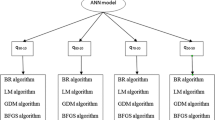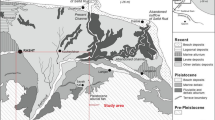Abstract
One of the most popular soil improvement methods is stone columns. So as to investigate the performance of this approach under different types of loadings, it is essential to obtain the displacement–load curve of the stone columns. In this paper, the effect of geotextile-encased stone columns has been evaluated based on 39 large scale tests in sand with different silt content. Furthermore, artificial neural network is carried on to estimate the shear resistance of the modeled stone columns by considering some factors such as fine content of bed soil, area replacement of stone columns, and normal stress on the sample. In the present research, artificial neural networks optimized by colonial competitive algorithm (ANN-ICA) were used and their results were compared with other methods. The obtained results showed that ICA-based artificial neural networks predicted lateral bearing capacity of short piles with a correlation coefficient of 0.9738 for training data and 0.9913 for test data. Moreover, the results of the model showed the superiority of ICA-based artificial neural networks compared to back-propagation artificial neural network methods.
















Similar content being viewed by others
References
Adalier K, Elgamal A, Meneses J, Baez J (2003) Stone columns as liquefaction countermeasure in non-plastic silty soils. Soil Dyn Earthq Eng 23(7):571–584
Alikroosh I, Nikraz H (2012) Predicting axial capacity of driven piles in cohesive soils using intelligent computing. Eng Appl Artif Intell 25:618–627
Ardalan H, Eslami A, Nariman-Zadeh N (2009) Piles shaft capacity from CPT and CPTu data by polynomial neural networks and genetic algorithms. Comput Geotech 36:616–625
Asgari A, Oliaei M, Bagheri M (2013) Numerical simulation of improvement of a liquefiable soil layer using stone column and pile-pinning techniques. Soil Dyn Earthq Eng 51:77–96
Atashpaz-Gargari E, Lucas C (2007) Imperialist competitive algorithm: an algorithm for optimization inspired by imperialistic competition. In IEEE congress on evolutionary computation, CEC 2007, pp 4661–4667
Babu MRD, Nayak S, Shivashankar R (2013) A critical review of construction, analysis and behaviour of stone columns. Geotech Geol Eng 31(1):1–22
Baranti M, Golshani AA, Yasrebi SS (2015) Determination of bearing capacity of displacement piles in sandy soils using artificial neural networks. Modares Civ Eng J 14:27–36 (in Persian)
Castro J, Sagaseta C (2011) Deformation and consolidation around encased stone columns. Geotext Geomembr 29(3):268–276
Cengiz C, Güler E (2018) Seismic behavior of geosynthetic encased columns and ordinary stone columns. Geotext Geomembr 46(1):40–51
Chen J-F, Li L-Y, Xue J-F, Feng S-Z (2015) Failure mechanism of geosynthetic encased stone columns in soft soils under embankment. Geotext Geomembr 43(5):424–431
Chik Z, Aljanabi QA (2014) Intelligent prediction of settlement ratio for soft clay with stone columns using embankment improvement techniques. Neural Comput Appl 25(1):73–82
Das M, Dey AM (2018) Prediction of bearing capacity of stone columns placed in soft clay using ANN model. Geotech Geol Eng 36(3):1845–1861
Das SK, Samui P, Sabat AK, Sitharam TG (2010) Prediction of swelling pressure of soil using artificial intelligence techniques. Environ Earth Sci 61(2):393–403
Das SK, Biswal RK, Sivakugan N, Das B (2011a) Classification of slopes and prediction of factor of safety using differential evolution neural networks. Environ Earth Sci 64(1):201–210
Das SK, Samui P, Sabat AK (2011b) Application of artificial intelligence to maximum dry density and unconfined compressive strength of cement stabilized soil. Geotech Geol Eng 29(3):329–342
Dash SK, Bora MC (2013) Influence of geosynthetic encasement on the performance of stone columns floating in soft clay. Can Geotech J 50(7):754–765
Debnath P, Dey AK (2017) Bearing capacity of geogrid reinforced sand over encased stone columns in soft clay. Geotext Geomembr 45(6):653–664
Fausett LV (1994) Fundamentals neural networks: architecture, algorithms, and applications. Prentice-Hall Inc., Englewood Cliffs
Hajihassani M, Jahed Armaghani D, Sohaei H, Tonnizam ME, Marto A (2014a) Prediction of airblast-overpressure induced by blasting using a hybrid artificial neural network and particle swarm optimization. Appl Acoust 80:57–67
Hajihassani M, Jahed Armaghani D, Marto A, Tonnizam ME (2014b) Ground vibration prediction in quarry blasting through an artificial neural network optimized by imperialist competitive algorithm. Bull Eng Geol Environ. https://doi.org/10.1007/s10064-014-0657-x
Hornik K, Stinchcombe M, White H (1989) Multilayer feedforward networks are universal approximators. Neural Netw 2:359–366
Kosko B (1994) Neural networks and fuzzy systems: a dynamical systems approach to machine intelligence. Prentice Hall, New Delhi
Mahin Roosta R, Farrokh H (2011) Prediction of stress–strain behavior in stonely material based on artificial neural networks. Modares Civ Eng J 14:83–95 (in Persian)
Mohapatra SR, Rajagopal K, Sharma J (2016) Direct shear tests on geosynthetic-encased granular columns. Geotext Geomembr 44(3):396–405
Momeni E, Nazir R Jahed, Armaghani D, Maizir H (2014) Prediction of pile bearing capacity using a hybrid genetic algorithm-based ANN. Comput Geotech 57:122–131
Murugesan S, Rajagopal K (2007) Model tests on geosynthetic-encased stone columns. Geosynth Int 14(6):346–354
Murugesan S, Rajagopal K (2008) Shear load tests on granular columns with and without geosynthetic encasement. Geotech Test J 32(1):35–44
Murugesan S, Rajagopal K (2010) Studies on the behavior of single and group of geosynthetic encasemed granular columns. J Geotech Geoenviron Eng 136(1):129–139
Naeini SA, Gholampoor N (2014) Cyclic behaviour of dry silty sand reinforced with a geotextile. Geotext Geomembr 42(6):611–619
Rashidian V, Hassanlourad M (2013) Application of an artificial neural network for modeling the mechanical behavior of carbonate soils. Int J Geomech 14(1):142–150
Seed HB, Booker JR (1977) Stabilization of potentially liquefiable sand deposits using stone drain systems. J Geotech Eng Div 103(7):757–768
Simpson PK (1990) Artificial neural system—foundation, paradigm, application and implementations. Pergamon Press, New York
Sonmez H, Gokceoglu C (2008) “Discussion on the paper by H. Gullu and E. Ercelebi, “A neural network approach for attenuation relationships: an application using strong ground motion data from Turkey. Eng Geol 97:91–93
Sonmez H, Gokceoglu C, Nefeslioglu HA, Kayabasi A (2006) Estimation of rock modulus: for intact rocks with an artificial neural network and for rock masses with a new empirical equation. Int J Rock Mech Min Sci 43:224–235
Tang L, Zhang X, Ling X (2015) Numerical simulation of centrifuge experiments on liquefaction mitigation of silty soils using stone columns. KSCE J Civ Eng 20(2):631–638
Yoo W, Kim B, Cho W (2014) Model test study on the behavior of geotextile encased sand pile in soft clay ground. KSCE J Civ Eng 19(3):592–601
Zhang MY, Liang L, Song HZ, Li Y, Peng WT (2012) Intelligent prediction for side friction of large-diameter and superlong steel pipe pile based on support vector machine. Appl Mech Mater 2012(170):747–750
Author information
Authors and Affiliations
Corresponding author
Additional information
Publisher's Note
Springer Nature remains neutral with regard to jurisdictional claims in published maps and institutional affiliations.
Rights and permissions
About this article
Cite this article
Ardakani, A., Dinarvand, R. & Namaei, A. Ultimate Shear Resistance of Silty Sands Improved by Stone Columns Estimation Using Neural Network and Imperialist Competitive Algorithm. Geotech Geol Eng 38, 1485–1496 (2020). https://doi.org/10.1007/s10706-019-01104-8
Received:
Accepted:
Published:
Issue Date:
DOI: https://doi.org/10.1007/s10706-019-01104-8




